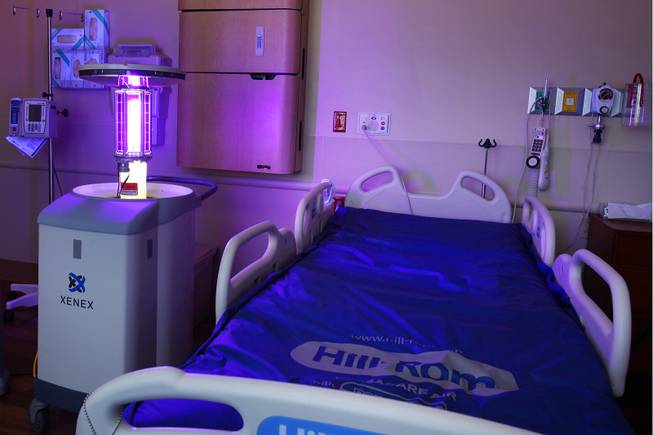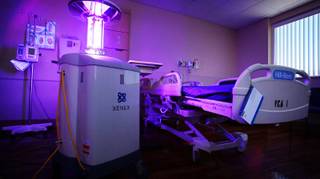
Xenex Healthcare Services portable room disinfection device is demonstrated at MountainView Hospital’s physical rehabilitation unit on Wednesday, June 20, 2012. MountainView is the first hospital in Nevada to employ the device, which uses blue ultraviolet light to disinfect rooms.
Thursday, June 21, 2012 | 2 a.m.
Hospital Disinfection Machine
Xenex Healthcare Services' portable room disinfection device is demonstrated at MountainView Hospital's physical rehabilitation unit on Wednesday, June 20, 2012. MountainView is the first hospital in Nevada to employ the device, which uses blue ultraviolet light to disinfect rooms.
The campaign to eliminate lethal, hospital-acquired infections is moving from buckets of bleach to a 4-foot-tall robot with a telescoping, disk-shaped head that emits bursts of ultra-violet light.
The device can be moved from one hospital room to another, where for five minutes or more it flashes 90 bursts of UV light per minute, destroying bacteria and viruses.
Its primary target: Methicillin-resistant Staphylococcus aureus (MRSA) or Clostridium difficile (C. diff), two of the most deadly and resistant bacteria that have a propensity to thrive in hospital environments.
In its series, “Do No Harm: Hospital Care in Las Vegas,” the Sun found that in 2008 and 2009, patients became infected with lethal drug-resistant “superbugs” in valley hospitals 2,010 times.
Two hundred thirty-nine patients died — although it’s impossible to tell from hospital billing records how or whether the infections factored in the patients’ deaths.
“There are germs that we can easily clean up, and then there are germs that are harder to get,” said Jan Olivas, the director of risk management and patient safety officer at MountainView Hospital, which is the first and only hospital in Nevada to acquire the device. “With this, we can blast the germs that are truly difficult to get rid of.”
The germ-zapping machine, about the size of a dorm refrigerator, is called the Xenex Healthcare Services Room Disinfection Device. The people who use it call her Rosie, for the robotic housekeeper made popular by the futuristic “Jetsons” cartoon.
Olivas said MountainView has a good record of fighting hospital-acquired infections and is adopting this new technology because “it’s the right thing to do. We like to be ahead of the curve.”
Traditionally, it is the duty of the housekeeping staff to keep hospitals as infection-free as possible. Staff members like Jesrell Munoz, who has worked for the housekeeping department for a year and a half, used to work with chemicals like bleach to attempt to disinfect hospital rooms.
But as strong and abrasive as bleach may be, it typically did little against super-bugs like C. diff.
“C. diff is a spore and has a very tough shell. It’s like a hard, waxy armor,” said Rachel Sparks, the technical director for Xenex. “The UV light is able to puncture the spore’s shell and disrupt the cell’s replication process, deactivating the germ.”
While the science behind the device is complex, the process to use the machine is surprisingly simple. Hospital housekeeping staff must undergo a 20-minute training meeting before they can add this disinfecting step to their daily routine.
“After our regular cleaning, we prepare the room [for the disinfection process],” said Munoz, who is trained to use the disinfecting machine. “We pull things out like drawers and cords, so the machine can catch all different spots in the room.”
The particular area Rosie is placed within a hospital room is decided based off a series of UV mapping done by the Xenex team. Rosie targets high-touch surfaces like IV poles, hand rails, even remote controls. Because C. diff is transmitted through contact, places that are frequently touched have a greater risk of carrying and spreading the bacteria.
“The protocol for deciding how long the machine is used in each room depends on the size of the room,” Hart said.
While people are not supposed to be in the room while Rosie is at work, “if a person were to stand in the room and look directly at the light for a long period of time, the worst that would happen is irritation to their eyes,” Sparks said.
About two dozen hospitals across the country have started using the technology.


Join the Discussion:
Check this out for a full explanation of our conversion to the LiveFyre commenting system and instructions on how to sign up for an account.
Full comments policy